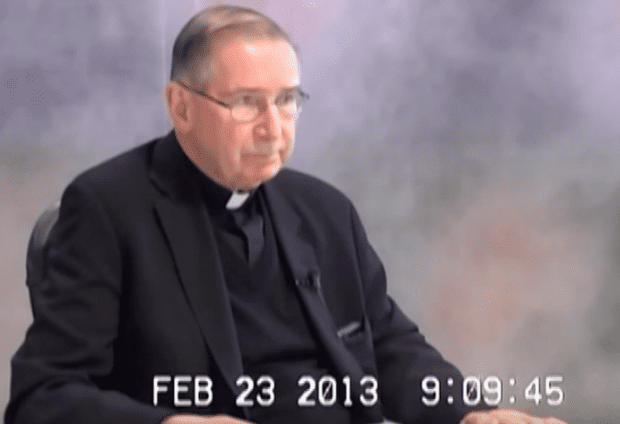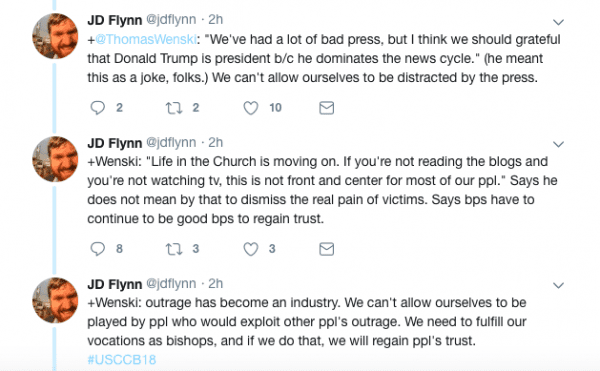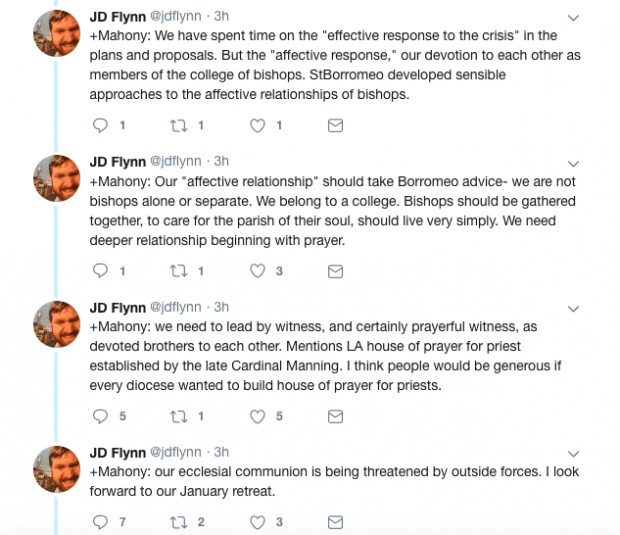Bishops: Brothers In A Dysfunctional Family

I’m reading Catholic News Agency editor J.D. Flynn’s excellent Twitter coverage of the US Conference of Catholic Bishops’ meeting, and it’s really depressing, though in an enlightening way. Everybody’s mad at the bishops, and believe me, I get that. Yet reading through the coverage, which includes quotes from the questions the bishops are asking of each other about how to police themselves on sexual misconduct, I keep thinking about how futile the effort is bound to be. I hope I’m wrong about that, but Flynn’s real-time coverage makes me wonder what on earth a bishop who earnestly wanted to do the right thing could possibly accomplish within the bounds of the Catholic institutional structure.
I’m seeing some serious questions asked by bishops (reported by Flynn), but before I get to them, let me share this series of tweets with you, referring to comments by the Archbishop of Miami:

Good. Grief. Let me tell you something about outrage, and Wenski’s archdiocese. Here’s a link to the long, ugly Gawker report about “the Catholic Church’s secret gay cabal” (their headline), centered on the Archdiocese of Miami. (NSFW.) Most of this happened under the previous archbishop; Wenski was sent in to clean things up. And maybe he has done that! But reading that 2011 account of the rampant homosexual corruption in that Archdiocese before Wenski got there in 2010, it’s a wonder that the Catholic Church in Miami has any credibility at all, much less communicants. If people aren’t outraged by what’s been happening, they aren’t paying attention. After McCarrick, the Don Corleone of the Church’s lavender mafia, no American bishop should be whining about the outrage industry.
More episcopal cluelessness, this a hundred times worse:

If Cardinal McCarrick was the Don Corleone of the lavender mafia, then Cardinal Mahony of Los Angeles is the Don Barzini. It is hard to overstate how rotten Roger Mahony’s record on sex abuse is. In 2013, the Washington Post editorialized, correctly, that Mahony is lucky to have avoided prison. More:
His continued prominence reflects the culture of impunity in the Catholic Church a decade after its tolerance and complicity in the abuse of children was exposed. The church has adopted policies intended to avoid fresh outrages, but it also has fought to protect supervisors who shielded criminal molesters.
Cardinal Mahony is a prime example. Even after his archdiocese reached a $660 million civil settlement with more than 500 victims of abuse in 2007, he and the hierarchy did everything in their power to avoid individual accountability. As recently as last week, church lawyers tried to keep secret the names of top officials and parish priests implicated in abuse cases. Fortunately, a California judge ordered disclosure of the relevant church personnel files.
That triggered publication of some 14,000 pages, including notes between Cardinal Mahony and a top aide showing that they repeatedly transferred abusive priests out of the country and the state to evade investigators and publicity. The cardinal also cautioned against exposing abusive priests to therapists who might be legally obligated to report their crimes.
The New York Times reported on the Mahony documents at the time. Excerpt:
Rather than defrocking priests and contacting the police, the archdiocese sent priests who had molested children to out-of-state treatment facilities, in large part because therapists in California were legally obligated to report any evidence of child abuse to the police, the files make clear.
In 1986, Cardinal Mahony wrote to a New Mexico treatment center where one abusive priest, Msgr. Peter Garcia, had been sent.
“I believe that if Monsignor Garcia were to reappear here within the archdiocese we might very well have some type of legal action filed in both the criminal and civil sectors,” Cardinal Mahony wrote.
Monsignor Garcia admitted to abusing more than a dozen young boys, most of them from families of illegal immigrants, since he was ordained in 1966, and in at least one case he threatened to have a boy he had molested deported if he talked about it, according to documents filed in court.
He was never criminally prosecuted, and has since died.
From a 2013 Los Angeles Times piece on how Mahony covered up abuse:
Mahony and his aides selected therapists who they knew wouldn’t report abuse to authorities, and urged suspected molesters to remain out of state to avoid police investigations and lawsuits. Mahony ordered one priest who had admitted preying on as many as 20 children to stay away from California “for the foreseeable future” to avoid prosecution.
Inside the Los Angeles Police Department’s Sexually Exploited Child unit, detectives had come to think of clergy cases as a footrace against the chancery. When a tip about a priest came in, the starting gun went off.
“Even if it was at the end of the day and we were supposed to go home, we knew we were at the starting post,” said Det. Dale Barraclough, who spent 20 years in the unit.
LAPD policy was to notify the archdiocese when an investigation was underway. But once the church was informed, Barraclough said, “we knew that the suspect, 99% sure, that he was going to be out of the country or out of state.”
Detectives begged parents not to inform the church and held off telling their own supervisors, Barraclough said in an interview, buying time to talk to witnesses, track down other victims, and seize toys and photos from rectories.
Officers often lost the race. In early 1988, police learned that a visiting priest allegedly molested several boys over nine months before fleeing to his native Mexico. In an effort to identify all the potential victims, detectives asked for a list of altar boys at two L.A. parishes.
Mahony was adamant that the roster not be provided: “We cannot give such a list for no cause whatsoever,” he wrote to aides in an internal memo.
Det. Gary Lyon became fed up and poured out the story of Father Nicolas Aguilar-Rivera to a Times reporter. Lyon told the newspaper that church officials knew the priest was leaving the country but contacted authorities only after he was gone. Now, Lyon complained, they were preventing police from identifying the children who may have been harmed.
Right, so this is the retired cardinal archbishop who dares to show up at the USCCB meeting and talk about the need for the bishops to focus on their affection for each other, and to consider asking each diocese to build a “house of prayer” for priests! The narcissism is boundless. In 2007, the Archdiocese of Los Angeles — led by Mahony from 1985 until his retirement in 2011 –settled all outstanding priest sex abuse cases for a record $660 million. Back in 2002, I remember conversations I had as a journalist with prominent Catholics in L.A. who feared that Mahony would pay anything to avoid having to testify under oath, and who were busily trying to move archdiocesan monies for charities and philanthropic works into accounts that Mahony couldn’t touch. Mahony never did testify about his leadership of the LA Archdiocese.
Canon lawyer and journalist Ed Condon correctly characterizes Mahony’s intervention today:
Cardinal Mahoney, formerly of LA, currently delivering a long intervention on “our devotion to each other as members of the college of bishops.” His presence echoes that of Cardinal Law speaking at same meeting in 2002.
— Ed Condon (@canonlawyered) November 13, 2018
https://platform.twitter.com/widgets.js
Does anybody doubt that if Bernard Law was still alive, and had come to this meeting, not a single bishop would have rebuked him in public or in private? Has even one bishop read the riot act to Cardinal Mahony? Or does their “affective relationship” preclude such unpleasantness.
True story: a Catholic layman I know saw a conservative bishop in the airport, headed to the 2002 Dallas meeting. The layman greeted the bishop, and said, “I’m glad to see that there will be at least one good bishop at this meeting.” The conservative prelate snapped, “They’re all good bishops.” He wasn’t joking.
What if the heart of the self-governance problem is this “affective relationship,” which obliges the righteous bishops to stay silent in the face of bad bishops’ corruption? One can easily understand their fear of the US Church becoming a disaster zone of warring factions, where the informal schism that has existed for a long time becomes clearer and sharper. But being nice and pretending that everything is just fine has brought them to this sinkhole, where they have no credibility left.
Look:
Cardinal DiNardo said he’s received thousands of letters from Catholics since the scandal broke this summer. “One thing that nags at everyone is the Archbishop McCarrick thing. It just seems to be ubiquitous. This is the one that has to be addressed.” #USCCB2018
— Daniel Burke (@BurkeCNN) November 13, 2018
https://platform.twitter.com/widgets.js
That’s because McCarrick is a condensed symbol of the entire crisis. He was a serial predator whose predation (of seminarians) was not much of a secret, for a long time. Yet he rose to the most elite level in the Catholic Church. He presented himself publicly as a faithful and irenic churchman, and, when the scandal broke in 2002, he took the lead public relations role as the voice of institutional reform. But he was a lying hypocrite — and without question more than a few bishops knew that he was a lying hypocrite. Nobody said anything. Nobody did anything. Such was the bishops’ affective relationship to each other. So, a lot of laypeople now have this crazy idea that the bishops are presiding over a racket — that the pursuit of holiness is boob bait to keep the laity comforted and distracted.
Sixteen years after Dallas, and they still cannot figure out how to govern themselves. They still give cretins like Roger Mahony a place of respect.
+@BishopBarron: This crisis began with McCarrick. Ppl want us to get to the bottom of McCarrick scandal, and we should pursue that. What is the status of the Holy See’s review of its own files? Can we bring “respectful pressure to bear” for an investigation?#USCCB18
— JD Flynn (@jdflynn) November 13, 2018
https://platform.twitter.com/widgets.js
“Respectful pressure.” One understands this; it’s the Pope he’s talking about. But at what point does “respectful” amount to a kind of capitulation? These men have been so “respectful” of each other and the pontiff that they have allowed the house to burn down but haven’t raised their voices out of fear of being impertinent. Maybe the problem is not the lack of procedures and policies, but the lack of moral courage, of character.
One quick take-away is this: If the February summit was already high-stakes, those stakes have now grown exponentially. For the Vatican to ask the bishops’ conference of the fourth-largest Catholic country in the world, and one deeply scarred by the crisis at the moment, to wait three months before taking meaningful action suggests the February meeting better deliver something dramatic, or, at least in this country, there will be blood in the water.
More:
In much American media discussion on Monday, casual references to “the Vatican” standing in the way of the U.S. bishops abounded. However, the plain truth is that under Francis, the traditional structures of the Vatican have lost most of their power in favor of personal leadership by the pope himself.
Sooner or later, the question will become not where “the Vatican” stands, but the pontiff himself.
Francis’s response to the Viganò allegations is an answer: he’s going to stonewall, portray the bishops and himself as victims, and continue to issue empty proclamations. Given the fact that the Catholic Church is a monarchy, it is hard to know what American bishops who are sick of the filth and the institutional rot, and who have a clear idea of the nature of this crisis, can do in the absence of effective leadership from the pope.
I can’t see how this crisis gets resolved. If you see a clear path forward, by all means let’s hear it. I believe that the Catholic Church will endure, but that those lay Catholics who are still around when the crisis ends will be those who took some form of the Benedict Option to strengthen themselves and their families while the moral authority of the Church’s institutional leadership collapsed. This thing is going to get a lot worse before it gets better.
Subscribe for as little as $5/mo to start commenting on Rod’s blog.